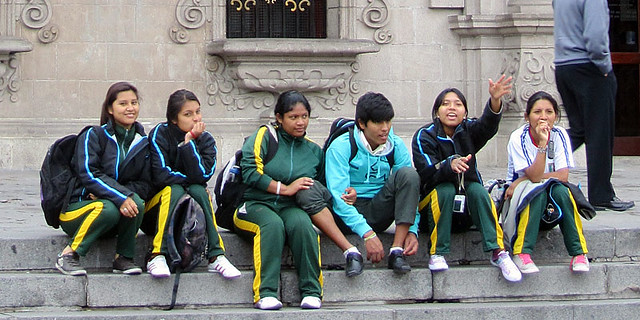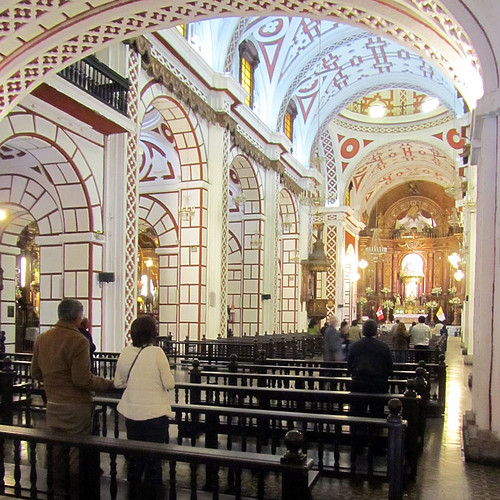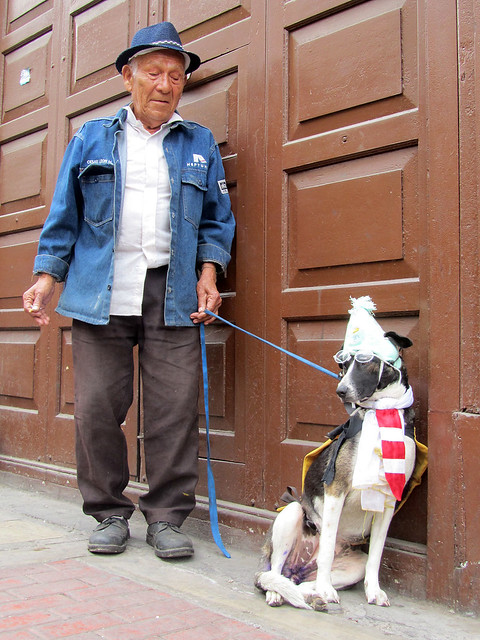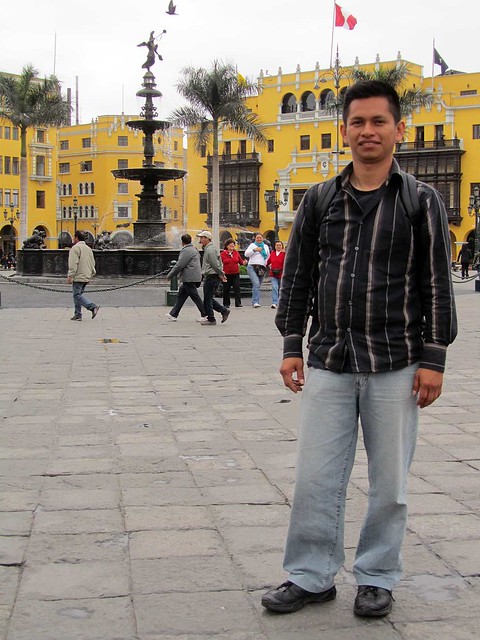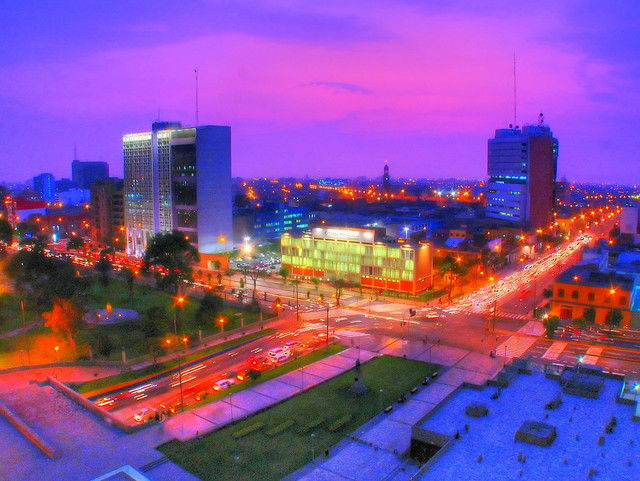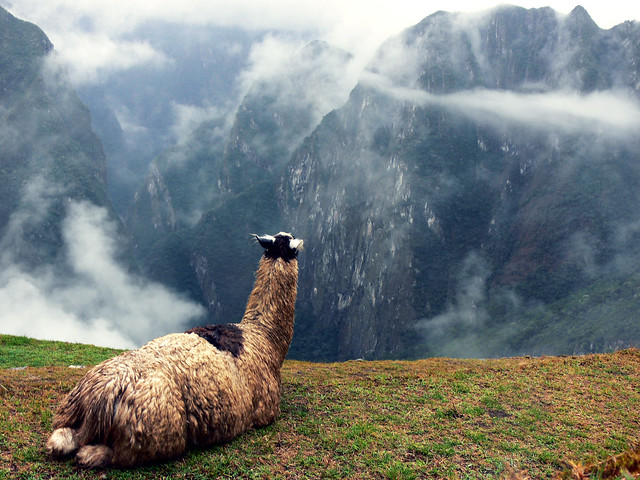Hola, todos! I am safe and sound in Lima and will soon depart for Cuzco. Before I go, I want to share a bit about the journey from Chicago to Peru. Generally, I don’t think of the actual travel part of travel as being very interesting. This time was different.
Things got off to a good start in Houston when una abuela asked me for help. In Spanish. And I was able to help her. In Spanish. We only exchanged a few sentences, but it felt good. The only problem? I forgot to use usted, and used the familiar form tú instead. Oops. (I also practiced my Spanish in flight by watching 30 Rock en español. For some reason, the show is even funnier when I barely understand a word.)
In-Flight Entertainment
I was seated next to Mark, who lives in California. He’s in Lima to visit his girlfriend. They met on a Latin American dating site and want to get married, but need to iron out some issues with her visa. He gave me some practical tips about getting around town. “Be careful of the taxis,” he told me. “They’ll try to rip you off.”
Note: A drunk young man was seated in front of us. He was loud but friendly. When the flight attendant chastised him for being so noisy, he was contrite. He offered to “buy everyone everything from the SkyMall catalog”. It would have been annoying, but he was sincere. Well, sincere and loud. Eventually he settled back to watch Captain America: The First Avenger. So did I — though not in Spanish.
Also on the flight was Ben, whom I’d met briefly at the airport. He came to find me, and he and Mark and I had a long conversation about travel in general and Peru in specific. Both Mark and Ben have traveled extensively. Ben has been traveling for 30 years, and has strong opinions about Americans who are stuck in the rat race.
“The world is full of abundance,” Ben told me. He stood in the aisle, using his styrofoam coffee cup to gesture for emphasis. “Food. Clothes. Housing. It’s all out there and will come to you if you let it. I mean it. Its true. ” I listened, but I didn’t say anything. If you’ve been reading my stuff for a while, you know what I think of the Law of Attraction.
Mark and Ben talked about their visits to Peru and Colombia. They agreed that Latin American women are beautiful, but that Colombian women are the most beautiful of all. I winced at the loudness of it all, especially when Ben began to generalize about Peru and Peruvians. (Mentally I noted that sometimes generalizations about Americans are correct.)
How NOT to Take a Taxi in Lima
I hesitate to tell the next anecdote because it’s precisely the sort of thing you’re not supposed to let happen to you in Peru, but truth is truth. I made a mistake, and I may as well be honest.
After clearing customs at the Lima airport, I wandered into the reception area, which is a large funnel of people. There were dozens of drivers holding signs, but nobody was holding a sign for me. Not ten minutes in the country and already I’d hit a snag! I went back through twice more but couldn’t find my transfer.
Not to worry. There were plenty of helpful taxi drivers offering to assist me. I brushed them off until one clever fellow convinced me to let him call my hotel. They had my reservation, he told me, but they didn’t have me down for an airport transfer.
“I can take you, señor,” he volunteered helpfully. (Read that “helpfully” with a touch of irony, please.)
“Cuanto cuesta?” I asked, not sure if that was the right way thing to say. He understood.
“Treinta soles, señor,” he said. That’s about $12, which sounded reasonable, so I agreed. He helped me put my bags into the back of his car.
I’d be lying if I said I wasn’t scared. I was a little scared. I’ve taken few taxi rides in my life, and I’ve heard too many warnings about taxi scams in Latin America — not just from Mark, but from other people. But my driver and I had a pleasant drive into Miraflores. Between his broken English and my broken Spanish, we made it work. I remembered to use usted. He complimented me on my Spanish, saying it was good for having studied only three months.
But then, as he was driving me through a dicey neighborhood, he asked me to pay him. “Now?” I asked.
“Si, señor,” he said.
“Thirty soles, right?” I said. Confirmation seemed like a formality.
“No,” he said. “Treinta dólares.”
I was caught off guard, and I tried to argue a little, but there was no use. He held firm. He even dug out some sort of rate card (although he wouldn’t let me hold it) where something was listed as $30 or 95 soles. In the end, I gave him 60 soles and $10, or about $31.60.
The rest of the drive was pleasant enough. I focused on practicing my Spanish, but inside I was steaming. I wasn’t mad at the driver. I was mad at myself. What a dope!
Even Worse
This morning I met Manolo, my liaison in Lima. “Where were you last night?” he asked. He had been at the airport, holding a sign for the travel company. I explained that I’d looked several times but seen nobody. I apologized profusely. “It’s okay,” he said. When I gave him my receipt for the taxi, he shook his head in disapproval. “You should have only paid maybe 22 soles,” he said.
Some personal finance whiz I am. I paid four times as much for a taxi as I should have. And I didn’t need to take one at all. But you know what? Lesson learned. I need to make this same taxi ride twice more while in Peru, and now I know what to expect.
As I mentioned, I spent the day seeing a few tiny pieces of Lima: Plaza de Armas in the city center, and the area of Miraflores around the hotel. More on that tomorrow. Right now, it’s time for bed. I need to catch an early-morning flight to Cuzco!

